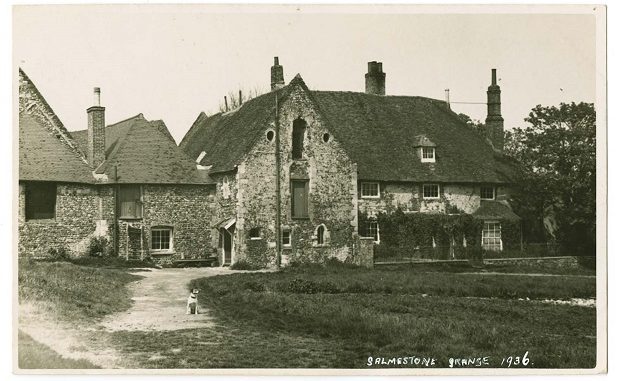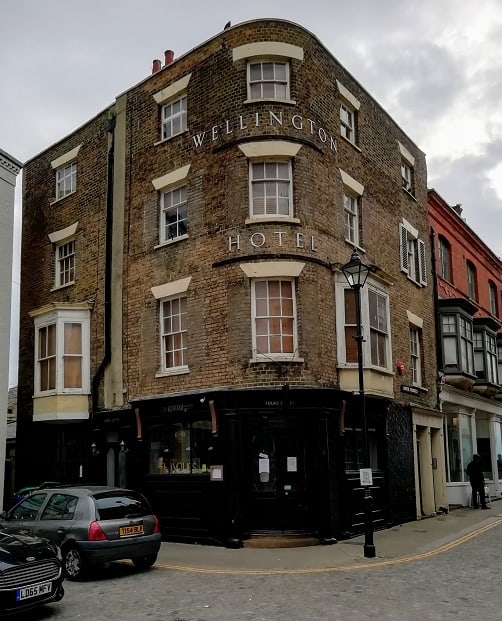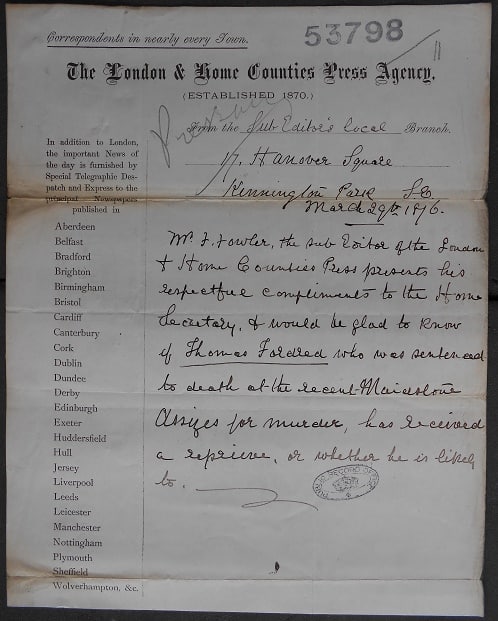
It was, briefly, the must visit locale in Thanet.
In early January 1876, several hundred people journeyed to Salmstone Corner, a mile south of Margate’s old town, to look at a large blood-stain.
For some it was a straightforward case of murder: a young woman brutally slain by her drunken paramour. Others believed differently, that Mary Ann Bridger, 29. was the unfortunate victim of manslaughter; that her life and that of her lover, Thomas Fordred. 49, had been destroyed by the evils of alcoholism.
Fordred, a farm labourer, already had a number of criminal convictions, which didn’t help his pleas of innocence.
Saturday evening, January 8, was cold and crisp, with a gibbous moon casting a metallic glow. The air was very still. At around 8.45pm Mary Sheaff, a labourer’s wife, was near Salmstone Corner when she heard a man’s drunken voice say: ‘You bugger, I will do you for that!’ In the semi-darkness she couldn’t see anyone. Frightened, she quickly continued on her way home.

Some two-and-a-half hours later, PC Samuel Stockbridge, was on duty outside Margate Police Station. He later recalled how he was approached by Thomas Fordred, his face and coat covered in blood. The labourer had come to report Mary’s death. ‘I detained the prisoner,’ Stockbridge later told Margate’s Magistrates, ‘and immediately informed the Superintendent’.
Superintendent Thomas Compton arrived and took Fordred’s statement. He then went to view Mary’s body at Salmstone Grange, accompanied by the police surgeon, Dr Crawshaw. The body lay in the barn covered with straw. When the Compton uncovered Mary’s corpse he found her bloodied, bruised and naked, with the exception of her stockings and boots.
At 3am the body was also examined by William Treves, a surgeon residing at 31 Dalby Square and two hours later Compton returned to Margate Police Station, where he charged Fordred with murder.
At the Coroner’s Inquest, a verdict of manslaughter was recorded but before the Magistrates, Fordred was charged with homicide, and it was on the latter charge that he appeared before Lord Coleridge at Maidstone’s Spring Assizes. Unsurprisingly, he pleaded not guilty to murder.
During the trial, Fordred’s statement was read to the court.
Both Bridger and he were known throughout Margate for their drunken behaviour and were regularly in trouble with the police. It was also rumoured that Fordred, of no fixed abode, was violent towards Mary and often used foul language at her. But she would never leave him, once saying to a concerned friend that she would ‘stick to him to the last’.
On that Saturday night, Fordred met Mary in the New Inn Pub at 5.10pm. During the course of the evening they drifted to the Wellington Arms and finally the Liverpool Arms. They also purchase pork and groceries for the week, before heading back to Salmstone at around 8pm. by which time they were both drunk.
According to Fordred, Mary kept falling over. Each time he’d pulled her to her feet, she fell down again. Each time she fell, she injured herself further. During one attempt to pick her up he even fell on top of her. Her clothes came undone and fell to the ground with each attempt. Finally, realising it was futile, Fordred continued to Salmstone by himself, leaving Mary alone, naked and exposed to the chill of a winter’s night.
At the farm’s stables, he solicited the help of George Emptage who assisted getting the seemingly unconscious woman across Fordred’s shoulders. On the journey back, Emptage later recalled how the accused looked ‘beery’. ‘He was not quite sober when he came to me,’ the 26-year-old wagon-driver told the court, ‘at least he did not seem to be’. Upon arriving back at the farm, Mary was deposited in the barn.

Ten minutes later, Fordred sought out Emptage again. Mary was dead, he announced, and he was going to report the incident to the police. Treve’s post mortem examination later revealed that death had occurred due to internal injuries caused by blunt trauma, possibly as a result of being repeatedly kicked.
Defence Counsel suggested that Fordred was guilty only of manslaughter, but Coleridge pointed out that the prisoner was charged with murder and therefore either guilty or innocent of that charge alone. It took the Jury fifteen minutes to fine him guilty.
In a strange twist, the people of Margate petitioned the Home Secretary Richard Cross to commuted Fordred’s death sentence to life imprisonment. Even the Coroner, William Payn, and Rev. Albert Harrisson, Chaplain at Maidstone Gaol, believed the verdict was wrong. Cross, however, ignored them all.
Thomas Fordred was hanged at 9am on April 4, 1876.

